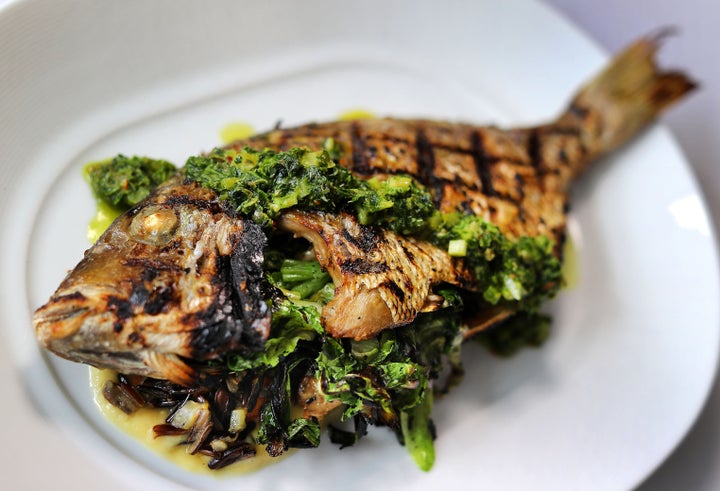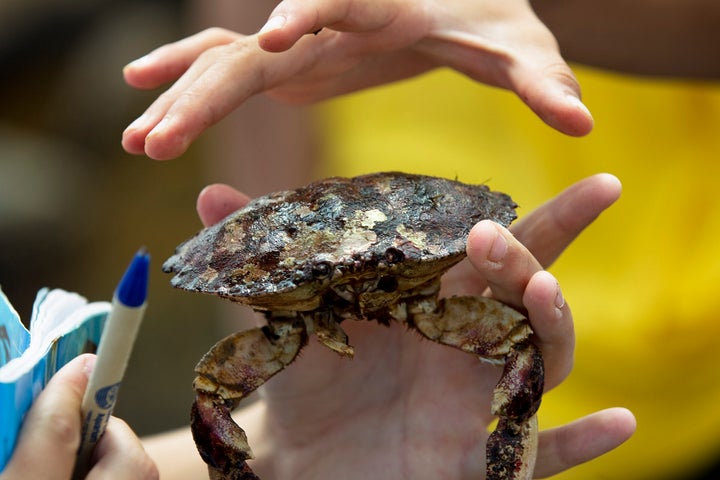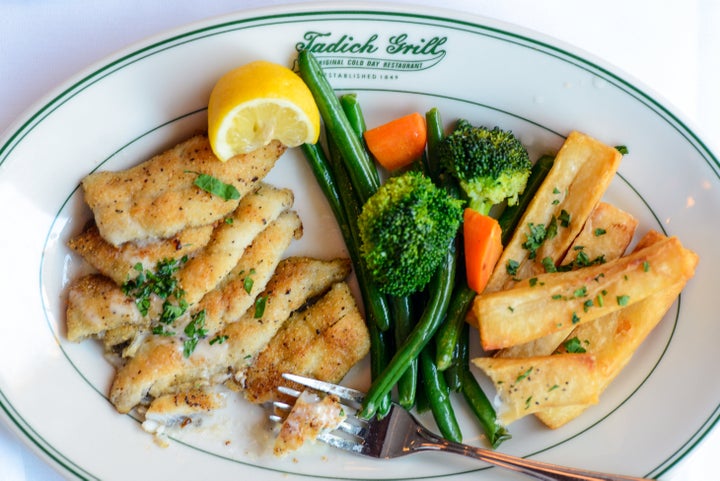As you probably already know, eating large quantities of certain types of tuna, salmon, mackerel, snapper and cod isn’t sustainable.
The U.S. has become an international leader in successfully managing and rebuilding depleted fish stocks, but according to the 2018 NOAA Fisheries report, the number of overfished species has increased — not only because of overfishing, but also climate change, pollution, disease and habitat degradation.
While convenient tools like the Monterey Bay Aquarium Seafood Watch app can help seafood lovers consume fish in a more environmentally friendly way, many Americans have no idea that fish considered bycatch (unwanted fish caught during commercial fishing), bait or even garbage in the U.S. can make for exceptionally good eating and shouldn’t go to waste.
Luckily, fishermen, chefs and ecological organizations across the country who recognize the value of so-called “trash fish” — some of which is quite popular in pockets of the U.S. and abroad — are working together to educate American consumers and broaden their taste buds.
HuffPost spoke with some of these experts to find out why eating a wider variety of fish is so beneficial and which types to look for on restaurant menus and in fish markets near you.
The Benefits Of Eating Bycatch
Saving money and reducing waste are among the many cogent reasons we should be eating more bycatch and fish that gets thrown away. “For consumers, preparing a food that would otherwise go to waste is the ultimate in sustainable purchasing,” said Dwayne Canfield, fisheries and coastal communities program manager at Ecotrust. “If you can get it, it’s usually more cost-effective. Underappreciated fish will often be cheaper.”
Stephanie Webb, a Ph.D. student at the University of California, Santa Cruz, is studying why “trash” or “bait” fish aren’t more readily available to consumers. She points out that, in addition to being more affordable, this type of seafood is often highly nutritious and lower in mercury. What’s more, increased demand for it would create a stronger market and allow fishermen to have more diverse sources of income throughout the year.
“For us, it’s all about eating in balance,” explained Kate Masury, program director for Eating With the Ecosystem. “So that means the most abundant species should be a much bigger part of our diet. Those that aren’t, it doesn’t mean we can’t eat them; it just shouldn’t be something we’re eating all the time.”
Marketing also plays a role. “Rather than calling it trash fish, we like to call them underloved,” quipped Alan Lovewell, founder and CEO of Real Good Fish. “We really have to diversify our diet and stop putting pressure on keystone species we love so much, like tuna, salmon and cod. We’re opening our eyes and stomachs to a world of flavors.”
“Rather than calling it trash fish, we like to call them underloved.”
- Alan Lovewell, founder and CEO of Real Good Fish
Lovewell marvels at how many Americans’ tastes have become so limited. “When you go to have that real authentic seafood experience in the Mediterranean, we’re happy to eat sardines and anchovies. But when we’re back home [in the U.S.], we’re looking for a mild, white, flaky fish that tastes like chicken. There’s very little emphasis on tasting the flavors of the ocean.”
Ben Sukle, chef and owner of restaurants Birch and Oberlin in Providence, Rhode Island, is a passionate advocate for serving locally caught and underutilized seafood to his patrons. “We have confidence in the product,” he told HuffPost. “Their reaction is, ‘It’s delicious.’”
The Best-Tasting ‘Underloved’ Seafood
Ready to dive in? Our experts provided a list of recommendations for the best sustainable seafood worth eating.
Atlantic Butterfish
Not to be mistaken with escolar, Masury describes this butterfish as a hand-sized forager that often gets caught alongside squid. The meat is white and flaky, has a mild, sweet flavor and is more oily than even cod or haddock. She recommends grilling, frying, baking, pan-searing or steaming them whole.
Scup
Sukle serves scup, also known as silver bass, in a raw crudo at his restaurant Oberlin. The flesh is slightly pink, very flavorful and extremely versatile. Masury recommends roasting it whole in the oven or grilling a fillet that’s been dressed with lemon and herbs.

Dog Fish
Known as rock salmon or rock cod in Europe, dogfish is great for frying and is often used for making fish and chips because it holds together better than cod or haddock, Masury said. The flesh is white, meaty and can also be seared or grilled.
Skate
If you’re partial to shellfish, Masury recommends skate for its mildly sweet flavor, which reminds her of scallops. After cooking, the texture is almost like crab meat when it breaks apart. She says Europeans are partial to eating pan-seared skate with a brown butter caper sauce. It can be found on both coasts.
Sea Robin
Although they have a very bony head and giant pectoral fins, the Atlantic sea robin has a tail that makes for good eating. Looking somewhat like a chicken drumstick, the flesh is meaty and makes a lovely addition to fish stew or bouillabaisse.
Jonah Crab
Favored for its sweet claw meat, this crustacean is found on the coast of New England.

Sand Crab
Also known as mole crabs or sand fleas, these bicoastal shellfish may not look pretty, but they’re definitely tasty. Simply steam them and crack them open to get at the meat.
Peekytoe Crab
Native to Maine, their meat (once picked from the shell) is perfect for making crab cakes or crab salad.
Acadian Redfish
This small East Coast fish has bright red scales and yields a mild and flaky white meat that’s perfect for making fish tacos.
Ground Fish
Bottom feeders tend to get a bad rap, but the increasing popularity of halibut has changed people’s attitudes (although it’s pricey). Instead, look for gray sole, summer flounder, winter flounder, yellowtail flounder and American plaice, especially during the winter.
Squid
While there are sizable squid fisheries on both U.S. coasts, most of the squid caught in the U.S. gets exported to countries in Asia, where it’s in high demand. But there’s plenty to go around on this side of the Pacific.

Anchovies
Prized in other parts of the world for their high oil content and savoriness, these tiny swimmers are good for more than just topping a Caesar salad. Because they’re highly perishable, they get flash-frozen at the point of catch, which Lovewell says is the best way to preserve the integrity of the fish.
Black Cod
Caught off the West Coast and mostly exported to Japan, black cod has been gaining popularity in local restaurants. You’re likely to find it at a Japanese restaurant, dressed in miso.
Pacific Grenadier
Described by Lovewell as a relatively unattractive bycatch of black cod, he says it’s like tilapia with better flavor and texture.
Sand Dabs
Lovewell describes sand dabs as “beautiful, delicate and really kind of cute.” These small flounders used to be considered a delicacy on the West Coast. They’re best battered and fried whole then deboned at the table. You might also find sand dab sandwiches at local fish markets.

Rock Crab
Similar to Florida stone crabs, these shellfish are prized for the sweet meat in their large, strong claws.
Ling Cod
Also known as buffalo cod, don’t be put off the greenish tinge of this fish’s flesh. Once it’s cooked, it turns white and is mild in flavor.
Gaper Clams
Often compared to geoduck (but not as large), Canfield says these mollusks are predominantly diver-caught in estuaries in Tillamook County, Oregon, and exported to Asia, but hopes they’ll also catch on here in the U.S.
Basket Cockles
Often used for baiting Dungeness crabs, Canfield explains that restaurants in places like New York City and Seattle are starting to create a market for these clams from Tillamook Bay, Oregon.
While these fruits of the sea may be available at local restaurants, fish markets and community-supported fisheries on either coast, some can be difficult to find. But don’t let that stop you from asking if vendors in your area will consider offering these fish and shellfish in the future so you can try them.